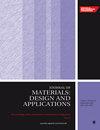Experimental investigations to assess surface fatigue failure in rolling contact bearing
IF 2.2
4区 材料科学
Q3 MATERIALS SCIENCE, MULTIDISCIPLINARY
Proceedings of the Institution of Mechanical Engineers, Part L: Journal of Materials: Design and Applications
Pub Date : 2024-05-28
DOI:10.1177/14644207241254448
引用次数: 0
Abstract
Rolling element bearings are the most important components in almost all rotating machines. These bearings are often subjected to repetitive load cycles at different operating conditions. Excessive loads, speeds, and improper operating conditions lead to the propagation of defects on their load-bearing surfaces, thereby causing a negative impact on the performance of rotating machines. This paper presents the results of experimental investigations to assess wear propagation in roller bearings using lubricant degradation, vibration, and statistical parameter analysis methods. A roller bearing setup was developed in the laboratory, and the test bearing (NJ 307E) was subjected to fatigue tests over a period of 900 h. The bearing was operated at a speed and radial load of 800 rpm and 1 kN, respectively. The film thickness analysis revealed a transition in lubrication regimes during 600–900 h of operation. Grease structure degradation and oxidation analyses were carried out using scanning electron microscope images and the Fourier transform infrared radiation technique. Further, the vibration signals are extracted from the bearing housing at regular intervals. Using the fast Fourier transform technique, these vibration signals were used to analyze bearing fault frequencies to highlight the faults developed on bearing contact surfaces. The statistical features of vibration signals such as root mean square, kurtosis, and crest factor were used to assess the severity of wear propagated on the bearing contact surfaces. Integrating tribological and vibration parameter analysis techniques provided a reliable assessment of surface fatigue wear propagated on the roller-bearing contact surfaces.评估滚动接触轴承表面疲劳失效的实验研究
滚动轴承是几乎所有旋转机械中最重要的部件。这些轴承经常在不同的工作条件下承受重复的载荷循环。过高的载荷、速度和不适当的工作条件会导致轴承承载表面的缺陷扩展,从而对旋转机械的性能产生负面影响。本文介绍了使用润滑剂降解、振动和统计参数分析方法评估滚子轴承磨损扩展的实验研究结果。在实验室中开发了一种滚子轴承装置,并对试验轴承(NJ 307E)进行了长达 900 小时的疲劳试验。油膜厚度分析表明,在运行 600-900 小时期间,润滑状态发生了转变。使用扫描电子显微镜图像和傅立叶变换红外辐射技术对润滑脂结构降解和氧化进行了分析。此外,还定期从轴承座中提取振动信号。利用快速傅里叶变换技术,这些振动信号被用来分析轴承故障频率,以突出轴承接触面上出现的故障。振动信号的统计特征,如均方根、峰度和波峰因数,用于评估轴承接触面磨损的严重程度。将摩擦学和振动参数分析技术相结合,可对滚子轴承接触表面的表面疲劳磨损进行可靠的评估。
本文章由计算机程序翻译,如有差异,请以英文原文为准。
求助全文
约1分钟内获得全文
求助全文
来源期刊

CiteScore
4.70
自引率
8.30%
发文量
166
审稿时长
3 months
期刊介绍:
The Journal of Materials: Design and Applications covers the usage and design of materials for application in an engineering context. The materials covered include metals, ceramics, and composites, as well as engineering polymers.
"The Journal of Materials Design and Applications is dedicated to publishing papers of the highest quality, in a timely fashion, covering a variety of important areas in materials technology. The Journal''s publishers have a wealth of publishing expertise and ensure that authors are given exemplary service. Every attention is given to publishing the papers as quickly as possible. The Journal has an excellent international reputation, with a corresponding international Editorial Board from a large number of different materials areas and disciplines advising the Editor." Professor Bill Banks - University of Strathclyde, UK
This journal is a member of the Committee on Publication Ethics (COPE).
 求助内容:
求助内容: 应助结果提醒方式:
应助结果提醒方式:


